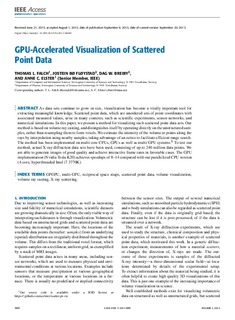GPU-Accelerated Visualization of Scattered Point Data
Journal article, Peer reviewed
Published version

Åpne
Permanent lenke
http://hdl.handle.net/11250/2624182Utgivelsesdato
2013Metadata
Vis full innførselSamlinger
- Institutt for datateknologi og informatikk [6778]
- Institutt for fysikk [2695]
- Publikasjoner fra CRIStin - NTNU [38127]
Sammendrag
As data sets continue to grow in size, visualization has become a vitally important tool for extracting meaningful knowledge. Scattered point data, which are unordered sets of point coordinates with associated measured values, arise in many contexts, such as scientific experiments, sensor networks, and numerical simulations. In this paper, we present a method for visualizing such scattered point data sets. Our method is based on volume ray casting, and distinguishes itself by operating directly on the unstructured samples, rather than resampling them to form voxels. We estimate the intensity of the volume at points along the rays by interpolation using nearby samples, taking advantage of an octree to facilitate efficient range search. The method has been implemented on multi-core CPUs, GPUs as well as multi-GPU systems. 1 To test our method, actual X-ray diffraction data sets have been used, consisting of up to 240 million data points. We are able to generate images of good quality and achieve interactive frame rates in favorable cases. The GPU implementation (Nvidia Tesla K20) achieves speedups of 8-14 compared with our parallelized CPU version (4-core, hyperthreaded Intel i7 3770K).